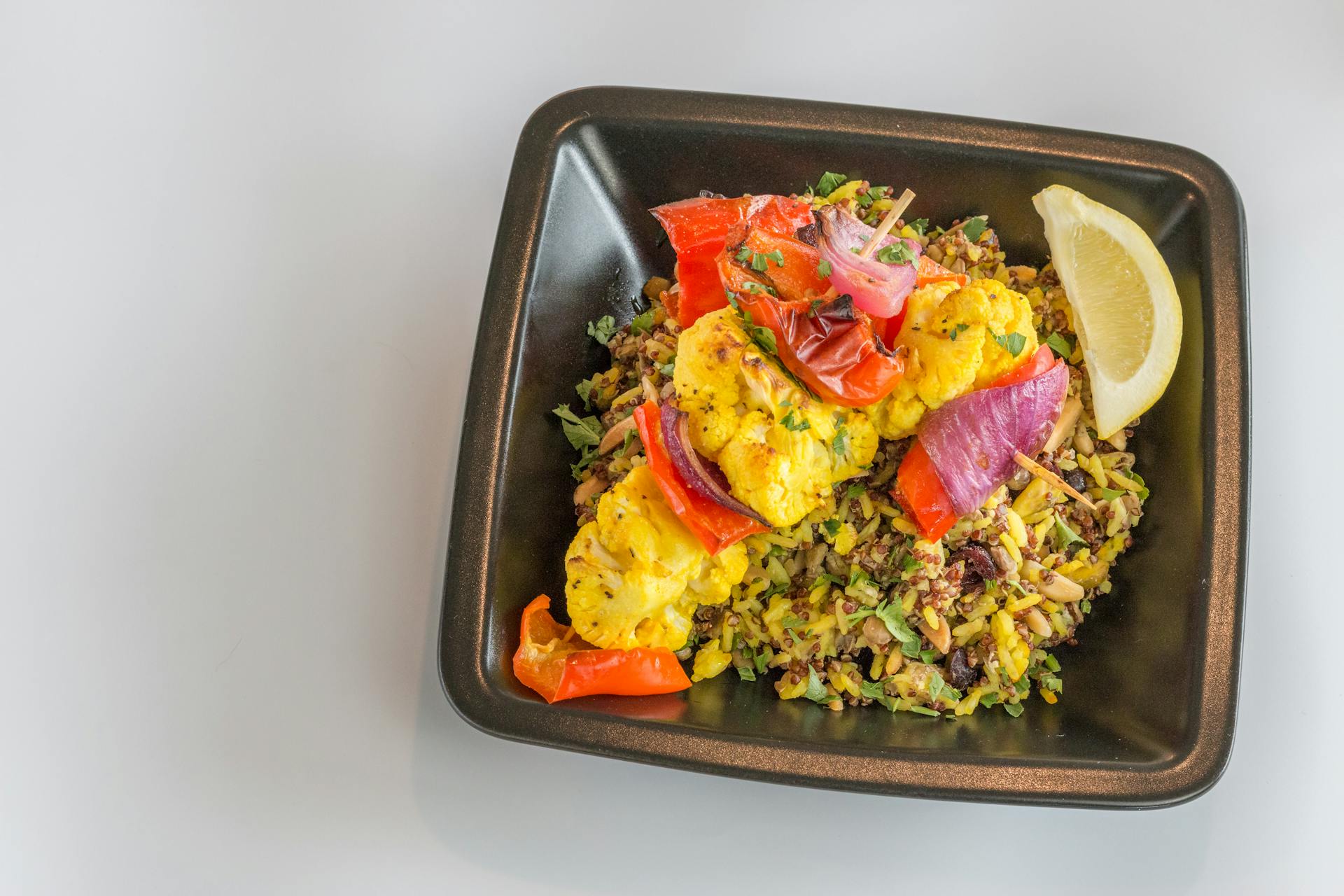
Carbohydrates can be a tricky subject when it comes to maintaining a healthy diet. Many carbohydrates, from breads to legumes, contain beneficial nutrition that should not be excluded from the diet. It is important to find a balance in the amount of carbohydrates consumed. So, which has more carbs – rice, potatoes or pasta?
When discussing carb content among these three items, potatoes are the clear winner. A regular-sized baked potato generally contains around 30 grams of carbohydrates, while one cup of white rice has 18 grams and one cup of cooked macaroni equals roughly 43 grams of carbs.
That being said, none of these foods are unhealthy and they should each have their place in a balanced diet. For example, potatoes contain additional vitamins and minerals such as potassium, magnesium and zinc. Rice provides B-vitamins that are not found in pasta or potatoes.
For those seeking a healthier carbohydrate option with fewer carbs present - quinoa features only 22 grams per cup cooked but also contains an abundance water-soluble vitamins and minerals like folate, potassium and iron and nine essential amino acids raising it above other carbohydrate sources[citation]. Quinoa’s protein content is also relatively high when compared to other grains; making it an excellent choice for those with dietary restrictions who need increased protein intake for growth and development as well as repairing muscles following exercise [citation].
When making a decision about which carbohydrate source you would like to incorporate into your diet you must take into account all the nutritional elements each food source possess that allows the body to run properly while also sourcing items with low levels of carbs per serving. By doing so you can make healthy and informed decisions on which foods you would like to consume while still receiving the nutrition your body needs!
Worth a look: Crispy Roasted Potatoes Potato Ribbons
Which has more carbohydrates: quinoa, oats, or barley?
When it comes to carbohydrates, many people look to grains such as quinoa, oats and barley to get their fix. While all three of these grains are high in carbohydrates and are frequently used in making bread, pastas, and even side dishes like rice – which one actually wins out when it comes to carbs?
Before we get into that, let’s look at the basics of carbohydrates. Carbs are one of the main macronutrients necessary for our bodies – the U.S. Department of Agriculture recommends about 45%-65% of daily calories should come from carbohydrates. So just how much do these grains contain? Well, one cup (160 g) of cooked quinoa contains about 44 g of carbs; oats contain 28 g carbohydrate per cup; and one cup (192 g) of barley provides 44 g carbohydrate.
When compared side by side, quinoa is the grain winner as far as carbohydrate quantity goes with 44 grams compared to oats with 28 grams and barley with also 44 grams per serving. However, barring quantity differences between cup servings or portion sizes of these grains consumed at each sitting, it’s important to note that quinoa is also higher in fiber than both oats and barley with 8 g versus 5g choice for both oats and barley making it a better option in the long run.
So if you’re looking for a healthier carb-packed option full of nutrients including dietary fiber choices – reach for some quinoa! This delicious grain is definitely the highest on the list when it comes to carbohydrates.
Which contains more carbs: bread, crackers, or tortillas?
Carbohydrates are an essential part of any health diet, and many foods contain varying levels of carbohydrates. For those looking to reduce their carb intake, comparing different types of food is an important part in making sure your meals remain balanced. The question then becomes - Which contains more carbs: bread, crackers, or tortillas?
When comparing the three food items, bread contains the most carbohydrates. A standard slice of white wheat bread can contain anywhere up to 15 grams of carbohydrates, while flavored bread generally has a slightly lower carbohydrate count at 11 grams per slice. Crackers come in second; a single serving usually contains about 9-12 grams of carbs and tend to be slightly lower in sugar than bread. Tortillas have the least amount of carbohydrates with 8-10 grams per serving. In comparison to the other two options, they are generally higher in fiber and protein - which can help give you an extra boost in energy throughout your day!
To sum up - when it comes to carb content, bread is highest followed by crackers and finally tortillas. However whichever you choose from these three should be enjoyed as part of a well-balanced and nutritious diet for a healthy lifestyle!
Which is higher in carbohydrates: sweet potatoes, yams, or plantains?
Carbohydrates are a common source of energy in many health-conscious diets worldwide. But which starchy root vegetable is higher in carbohydrates? This can vary depending on the size and weight of each vegetable.
Sweet potatoes are typically higher in carbohydrates than yams and plantains. In 100 grams of sweet potatoes, there is 20.1 grams of carbohydrates, while yams may contain only 15.3 grams and plantains can have as little as 16.2 grams of carbohydrates—provided the serving size is held consistent for all vegetables.
However, when comparing different serving sizes, it's generally easier to compare the caloric content rather than carbohydrates because carb density varies less with serving size than calories do. In 100 calories of sweet potatoes, there is 17.8 grams of carbs; for yams, this number drops to 10grams; meanwhile, plantains contain a meager 11g per 100 calories. Sweet potatoes also bags a win if you're comparing based on sugar content—7.39g per 100g compared with 6.44g in yams and 4.35g in plantains per respective weights!
Overall when comparing which root vegetable is higher in carbohydrates it appears that sweet potatoes have a firm edge over yams or plantains with varying comparisons between serving sizes or caloric contents being slightly different but not drastically so compared to sweet potato content numbers!
Additional reading: Buy Sweet Potato Noodles
Which has more carbohydrates: apples, oranges, or bananas?
Apples, oranges, and bananas are all delicious fruits that contain different types and amounts of carbohydrates, so the answer to the question of which has more carbohydrates depends wholly on the type and portion size.
When we compare a standard-sized portion of all three fruits, apples contain the highest amount of carbohydrates overall – approximately 19.5g per apple. This is due to an abundant presence of sucrose and fructose found in apples that makes them sweeter than oranges or bananas. That being said, if you decide to eat a generous portion size of either oranges or bananas – almost twice as much – you’ll receive a higher amount of carbohydrates than if you had eaten two apples. A large orange contains approximately 20g and a single banana contains around 23-24g of carbohydrates.
Despite these differences, all three options are healthy sources of naturally occurring fructose and sucrose, making them suitable snacks for people with diabetes who must regulate their half-hourly blood sugar levels. Therefore, when deciding which fruit has the most carbohydrates, it is important to consider both the type and portion size before coming to a conclusion.
Which has a higher carbohydrate content: cauliflower, broccoli, or cabbage?
Cauliflower, broccoli and cabbage all contain a great deal of healthy carbohydrates that help provide the body with energy. However, the amount of carbohydrates actually varies somewhat from one to the other.
Cauliflower is found to have the lowest carbohydrate content out of the three vegetables, with just 5 grams per cup when cooked. Broccoli several carbs more than cauliflower at 6.64 grams per cup when cooked. That makes cabbage the highest in carbs out of all three vegetables, possessing about 7.4 grams of carbs in a single cooked cup.
It is important to remember that these vegetables also provide essential nutrients such as Vitamin C and potassium, so they are still a viable option for those seeking to eat healthy without consuming too many carbohydrates. Additionally, since all three vegetables are low-calorie foods, they make wonderful accompaniments in many different dishes while still ensuring you're getting your daily intake of vitamins and minerals. When it comes down to it, all three vegetables can make excellent additions to any diet –but knowing which one has the most or least carbs certainly helps when it comes time for meal planning!
Curious to learn more? Check out: Cauliflower Rice
Which has the higher carbohydrate content: brown rice, wild rice, or white rice?
Brown rice, wild rice, and white rice all have high carbohydrate content. While there are small variations between each types of rice, the main difference lies in the type of carbohydrate present. Brown rice has the highest content of complex carbohydrates that are broken down slowly over a long period of time, providing more sustained energy and being beneficial to digestion. Wild rice generally has a higher content of simple carbohydrates than brown rice, which again, provide a more immediate form of energy as well as fiber, which can help keep digestive systems functioning. White rice is similar to wild rice in terms of its carbohydrate levels but it has been refined and milled which strips away many of its beneficial properties like vitamins, enzymes and proteins.
Ultimately, brown rice is the healthiest option when looking to choose a type of rice that is high in carbohydrates. Since it is denser and takes longer to break down in the body, it helps keep you feeling full for longer with fewer calories than other forms of carbohydrates like white or wild rice. Not only that but it has an impressive array of micronutrients and antioxidants which help benefit your overall health.
For your interest: Brown Rice
Featured Images: pexels.com


